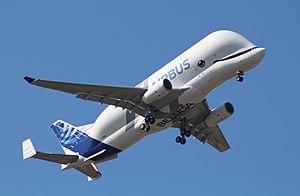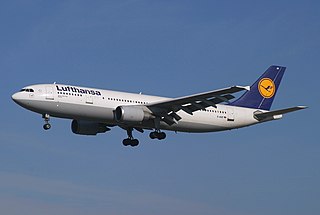
The Airbus A300 is a wide-body airliner developed and manufactured by Airbus. In September 1967, aircraft manufacturers in the United Kingdom, France, and West Germany signed a memorandum of understanding to develop a large airliner. West Germany and France reached an agreement on 29 May 1969 after the British withdrew from the project on 10 April 1969. European collaborative aerospace manufacturer Airbus Industrie was formally created on 18 December 1970 to develop and produce it. The prototype first flew on 28 October 1972.

The Airbus A320 family are narrow-body airliners developed and produced by Airbus. The A320 was launched in March 1984, first flew on 22 February 1987, and was introduced in April 1988 by Air France. The first member of the family was followed by the longer A321, the shorter A319, and the even shorter A318 . Final assembly takes place in Toulouse in France; Hamburg in Germany; Tianjin in China since 2009; and in Mobile, Alabama in the United States since April 2016.

The Airbus A321 is a member of the Airbus A320 family of short to medium range, narrow-body, commercial passenger twin engine jet airliners; it carries 185 to 236 passengers. It has a stretched fuselage which was the first derivative of the baseline A320 and entered service in 1994 about six years after the original A320. The aircraft shares a common type rating with all other Airbus A320-family variants, allowing previous A320-family pilots to fly the aircraft without the need for further training.

The Airbus A330 is a wide-body aircraft developed and produced by Airbus. Airbus conceived several derivatives of the A300, its first airliner in the mid-1970s. Then the company began development on the A330 twinjet in parallel with the A340 quadjet and launched both designs with their first orders in June 1987. The A330-300, the first variant, took its maiden flight in November 1992 and entered service with Air Inter in January 1994. The slightly shorter A330-200 variant followed in 1998.

The Airbus A380 is a large wide-body airliner that was developed and produced by Airbus. It is the world's largest passenger airliner. Airbus studies started in 1988, and the project was announced in 1990 to challenge the dominance of the Boeing 747 in the long-haul market. The then-designated A3XX project was presented in 1994; Airbus launched the €9.5 billion ($10.7 billion) A380 programme on 19 December 2000. The first prototype was unveiled in Toulouse on 18 January 2005, with its first flight on 27 April 2005. It then obtained its type certificate from the European Aviation Safety Agency (EASA) and the US Federal Aviation Administration (FAA) on 12 December 2006. Due to difficulties with the electrical wiring, the initial production was delayed by two years and the development costs almost doubled.

A wide-body aircraft, also known as a twin-aisle aircraft, is an airliner with a fuselage wide enough to accommodate two passenger aisles with seven or more seats abreast. The typical fuselage diameter is 5 to 6 m. In the typical wide-body economy cabin, passengers are seated seven to ten abreast, allowing a total capacity of 200 to 850 passengers. The largest wide-body aircraft are over 6 m (20 ft) wide, and can accommodate up to eleven passengers abreast in high-density configurations.

The Airbus A300-600ST, or Beluga, is a version of the standard A300-600 wide-body airliner modified to carry aircraft parts and outsize cargo. It received the official name of Super Transporter early on; however, the name Beluga, a whale it resembles, gained popularity and has since been officially adopted. Its replacement, the Beluga XL, entered service in January 2020.

The Airbus A400M Atlas is a European four-engine turboprop military transport aircraft. It was designed by Airbus Military as a tactical airlifter with strategic capabilities to replace older transport aircraft, such as the Transall C-160 and the Lockheed C-130 Hercules. The A400M is sized between the C-130 and the Boeing C-17 Globemaster III; it can carry heavier loads than the C-130 and is able to use rough landing strips. Along with the transport role, the A400M can perform aerial refueling and medical evacuation when fitted with appropriate equipment.
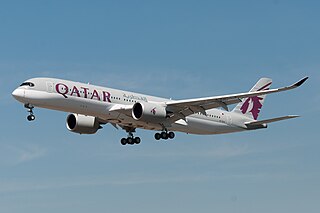
The Airbus A350 is a long-range, wide-body airliner developed and produced by Airbus. The first A350 design proposed by Airbus in 2004, in response to the Boeing 787 Dreamliner, would have been a development of the A330 with composite wings and new engines. As market support was inadequate, in 2006, Airbus switched to a clean-sheet "XWB" design, powered by Rolls-Royce Trent XWB turbofan engines. The prototype first flew on 14 June 2013 from Toulouse in France. Type certification from the European Aviation Safety Agency (EASA) was obtained in September 2014, followed by certification from the Federal Aviation Administration (FAA) two months later.

A cargo aircraft is a fixed-wing aircraft that is designed or converted for the carriage of cargo rather than passengers. Such aircraft usually do not incorporate passenger amenities and generally feature one or more large doors for loading cargo. Freighters may be operated by civil passenger or cargo airlines, by private individuals or by the armed forces of individual countries.
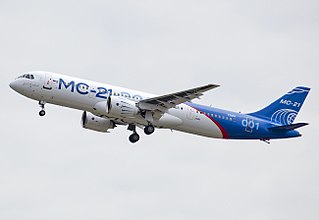
The Irkut MC-21 is a single-aisle airliner, developed in Russia by the Yakovlev Design Bureau and produced by its parent Irkut, a branch of the United Aircraft Corporation (UAC), itself a 92%-owned subsidiary of Russia’s state-owned aviation giant Rostec. The program was launched in 2007. Irkut rolled out the first MC-21-300 on 8 June 2016 and first flew the aircraft on 28 May 2017. After several years of delays, the first deliveries are expected for Russian airlines in 2022 and international customers in 2025.

Hawarden Airport, is an airport near Hawarden in Flintshire, Wales, near the border with England and 3.5 NM west southwest of the English city of Chester.
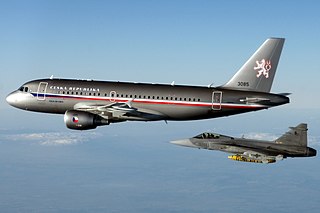
Airbus Corporate Jets, a business unit of Airbus SAS and part of Airbus, markets and completes corporate jet variants from the parent's airliner range. Types include the A318 Elite to the double/triple-decked Airbus A380 Prestige. Following the entry of the 737 based Boeing Business Jet, Airbus joined the business jet market with the A319 Corporate Jet in 1997. Although the term Airbus Corporate jet was initially used only for the A319CJ, it is now often used for all models, including the VIP widebodies. As of June 2019, 213 corporate and private jets are operating; 222 aircraft have been ordered, including 128 A320 family jets.
The Emirates fleet is composed of two wide-bodied aircraft families, the Airbus A380 and Boeing 777. The airline also has the Airbus A350-900, Boeing 777X and Boeing 787-9 aircraft on order.

The Airbus A320neo family is a development of the A320 family of narrow-body airliners produced by Airbus. The A320neo family is based on the previous A319, A320 and A321, which was renamed to A320ceo, for "current engine option".

The Airbus A330neo is a wide-body airliner developed by Airbus from the Airbus A330. A new version with modern engines comparable to those developed for the Boeing 787 was called for by operators of the original A330 series. It was launched on 14 July 2014 at the Farnborough Airshow, promising 14% better fuel economy per seat. It is exclusively powered by the Rolls-Royce Trent 7000 with double bypass ratio, in contrast to its predecessor.
Stelia Aerospace is an aerospace company headquartered in Toulouse, France. It specialises in the design and manufacture of aerostructures, pilot seats and premium class passenger seats mainly for the commercial aviation sector.
This is a list of aviation-related events in 2018.

Saint-Nazaire Montoir Airport also referred to as Aéroport de Gron is a primary commercial airport that serves Saint-Nazaire.
